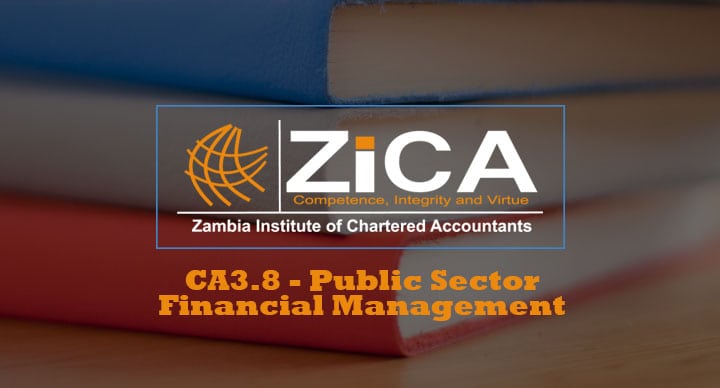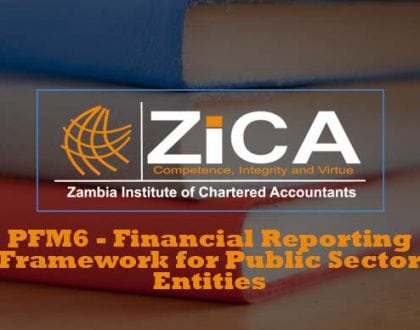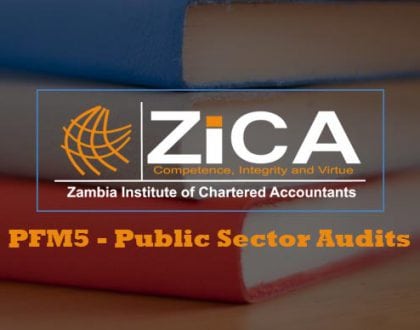CA3.8 – Public Sector Financial Management
No access plans exist.

Course Features
Course Details
CA3.8-Public Sector Financial Management
On completion of this module, candidates will reach a competency sufficient to be able to:- Explain the nature of the public sector finance and taxation framework in Zambia
- Describe the sources of public revenue and key areas of public expenditure
- Evaluate the nature of public sector budgeting and control systems
- Evaluate the public financial management system using measurement frameworks
- Recommend appropriate risk strategies for public sector financial management
- Evaluate public sector capital projects
| Syllabus topics | Weighting (%) | LO |
| Public sector finance and taxation framework in Zambia | 20 | 1 and 2 |
| Budgeting and control | 20 | 3 |
| Public Finance Management Measurement Frameworks | 10 | 4 |
| Financial Risk management | 25 | 5 |
| Capital projects | 25 | 4 |
Learning outcomes
- LO1: Explain the nature of the public sector finance and taxation framework in Zambia
- LO2: Describe the sources of public revenue and key areas of public expenditure
- LO3: Evaluate the nature of public sector budgeting and control system
- LO4: Evaluate the public financial management system using measurement frameworks
- LO5: Recommend appropriate financial risk strategies
- LO6: Evaluate public sector capital projects
- Public sector finance and taxation framework in Zambia: LO1, 2
- Identify the main governmental and administrative bodies with responsibility over public revenue and expenditure
- Identify the sources of public revenue for central and local government in Zambia
- Identify the key areas of public expenditure for central and local government in Zambia
- Explain the policy priorities for public expenditure in Zambia
- Explain the nature of financial risk in the public sector and identify, evaluate and recommend appropriate financial risk mitigation strategies, including those relating to public borrowing and financial market risks.
- Budgeting and control: LO3
- Outline the public financial planning process
- Explain the critical dimensions of public financial management performance from the Public Expenditure and Financial Accountability (PEFA) framework
- Describe the budgetary framework, budget cycle and budget processes, including the nature of performance measures, target setting, budget monitoring, budget feedback and control
- Explain the budgetary risk management framework and procedures and recommend appropriate risk mitigation strategies
- PFM Measurement Frameworks: LO4
- Explain the how the public financial management (PFM) system is measured
- Evaluate the PFM system using the Public Expenditure and Financial Accountability (PEFA) framework
- Evaluate the PFM system using other measurement frameworks such as Public Expenditure Tracking Survey (PETS) framework, etc.
- Financial Risk management: LO5
- Evaluate the risk of capital projects including the identification and proposed mitigation of risk factors, including:
- Sensitivity
- Simulation
- Scenario building
- Evaluate and recommend investment strategies for the use of surplus public funds in the context of the Public Finance Act and the Local Government Management Act, paying attention to:
- The identification of appropriate investment vehicles such as pension funds
- Using portfolio theory, the creation of a balanced portfolio of investments, as far as the relevant legislation allows.
- Evaluate the risk of capital projects including the identification and proposed mitigation of risk factors, including:
- Capital projects: LO6
- Describe the nature of public sector capital projects including the approval process, performance measures, and target setting, paying particular attention to public/private partnerships
- Explain the role of and interaction between quantifiable and non-quantifiable targets and apply both sets of targets to capital project problems
- Determine an appropriate cost of capital to employ in capital projects
- Evaluate, using appropriate techniques, the viability of proposed capital projects
This course does not have any sections.





